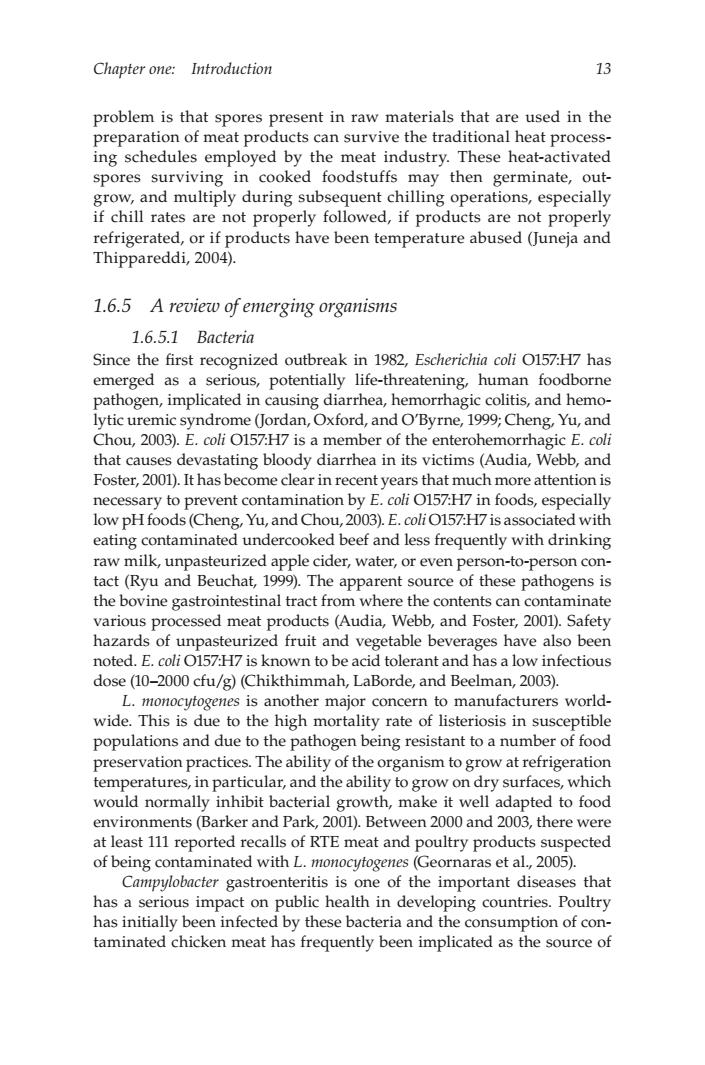正在加载图片...

Chapter one:Introduction 13 problem is that spores present in raw materials that are used in the preparation of meat products can survive the traditional heat process- ing schedules emploved by the meat industry.These heat-activated spores surviving in cooked foodstuffs may then germinate out grow and multiply during subsequent chilling operations,especially if chill rates are not properly followed,if products are not properly refrigerated,or if products have been temperature abused (Juneja and Thippareddi,2004). 1.6.5 A review of emerging organisms 1.6.5.1 Bacteria Since the first recognized outbreak in 1982,Escherichia coli O157:H7 has emerged as a serious,potentially life-threatening,human foodborne pathogen,implicated in causing diarrhea,hemorrhagic colitis,and hemo- lytic uremic syndrome (Jordan,Oxford,and O'Byrne,1999;Cheng,Yu,and Chou,2003).E.coli O157:H7 is a member of the gic E.coli that causes devastating bloody diarrhea in its victims(Audia,Webb,and Foster,2001).It has become clear in recent years that much more attention is necessary to prevent contamination by E.coli O157:H7 in foods,especially low pH foods(Cheng,Yu,and Chou,2003).E.coli O157:H7 is associated with eating contamina d undercooked beef and less frequently with drinking raw milk,unpasteurized apple cider,water,or even person-to-person con- tact(Ryu and Beuchat,1999).The apparent source of these pathogens is the bovine gastrointestinal tract from where the contents can contaminate various processed meat products(Audia,Webb,and Foster,2001).Safety haz rds unpast d fruit a dve etable bever ges have also been noted.E.coli O157:H7 is known to be acid tolerant and has a low infectious dose(10-2000 cfu/g)(Chikthimmah,LaBorde,and Beelman,2003). L.monocytogenes is another major concern to manufacturers world- wide.This is due to the high mortality rate of listeriosis in susceptible populations and due to the pathogen being resistant to a number of food preservation practices.The ability of the organism to grow at refrigeration temperatures,in particular,and the ability to grow on dry surfaces,which would normally inhibit bacterial growth,make it well adapted to food er ents(Ba er and Park,2001).Between 2000 and 2003,there wer at least 111 reported recalls of RTE meat and poultry products suspected of being contaminated with L.monocutogenes (Geornaras et al.2005). Campylobacter gastroenteritis is one of the important diseases that has a serious impact n public health in developing Poultry has initially be en infected by these bacteria and the con sumption of con taminated chicken meat has frequently been implicated as the source of Chapter one: Introduction 13 problem is that spores present in raw materials that are used in the preparation of meat products can survive the traditional heat processing schedules employed by the meat industry. These heat-activated spores surviving in cooked foodstuffs may then germinate, outgrow, and multiply during subsequent chilling operations, especially if chill rates are not properly followed, if products are not properly refrigerated, or if products have been temperature abused (Juneja and Thippareddi, 2004). 1.6.5 A review of emerging organisms 1.6.5.1 Bacteria Since the first recognized outbreak in 1982, Escherichia coli O157:H7 has emerged as a serious, potentially life-threatening, human foodborne pathogen, implicated in causing diarrhea, hemorrhagic colitis, and hemolytic uremic syndrome (Jordan, Oxford, and O’Byrne, 1999; Cheng, Yu, and Chou, 2003). E. coli O157:H7 is a member of the enterohemorrhagic E. coli that causes devastating bloody diarrhea in its victims (Audia, Webb, and Foster, 2001). It has become clear in recent years that much more attention is necessary to prevent contamination by E. coli O157:H7 in foods, especially low pH foods (Cheng, Yu, and Chou, 2003). E. coli O157:H7 is associated with eating contaminated undercooked beef and less frequently with drinking raw milk, unpasteurized apple cider, water, or even person-to-person contact (Ryu and Beuchat, 1999). The apparent source of these pathogens is the bovine gastrointestinal tract from where the contents can contaminate various processed meat products (Audia, Webb, and Foster, 2001). Safety hazards of unpasteurized fruit and vegetable beverages have also been noted. E. coli O157:H7 is known to be acid tolerant and has a low infectious dose (10–2000 cfu/g) (Chikthimmah, LaBorde, and Beelman, 2003). L. monocytogenes is another major concern to manufacturers worldwide. This is due to the high mortality rate of listeriosis in susceptible populations and due to the pathogen being resistant to a number of food preservation practices. The ability of the organism to grow at refrigeration temperatures, in particular, and the ability to grow on dry surfaces, which would normally inhibit bacterial growth, make it well adapted to food environments (Barker and Park, 2001). Between 2000 and 2003, there were at least 111 reported recalls of RTE meat and poultry products suspected of being contaminated with L. monocytogenes (Geornaras et al., 2005). Campylobacter gastroenteritis is one of the important diseases that has a serious impact on public health in developing countries. Poultry has initially been infected by these bacteria and the consumption of contaminated chicken meat has frequently been implicated as the source of